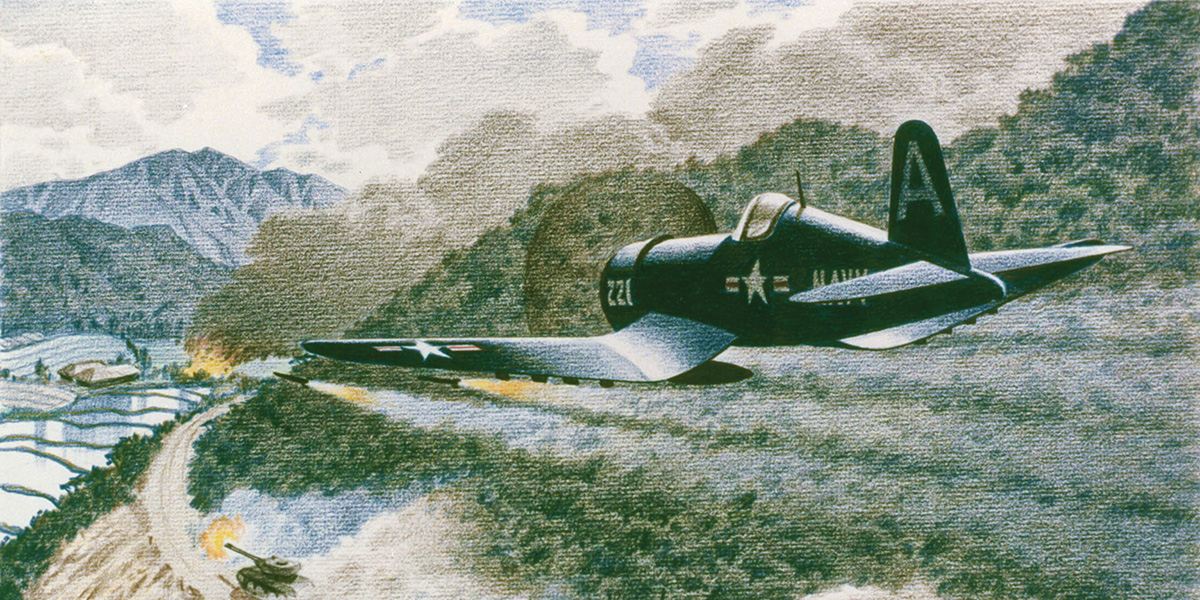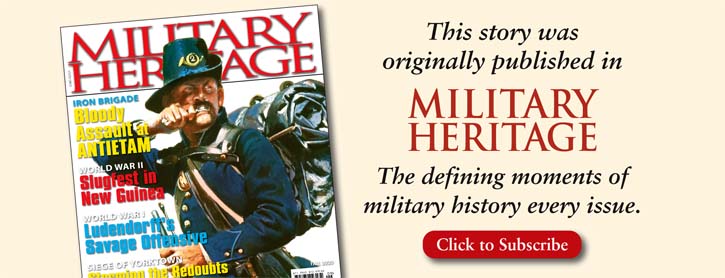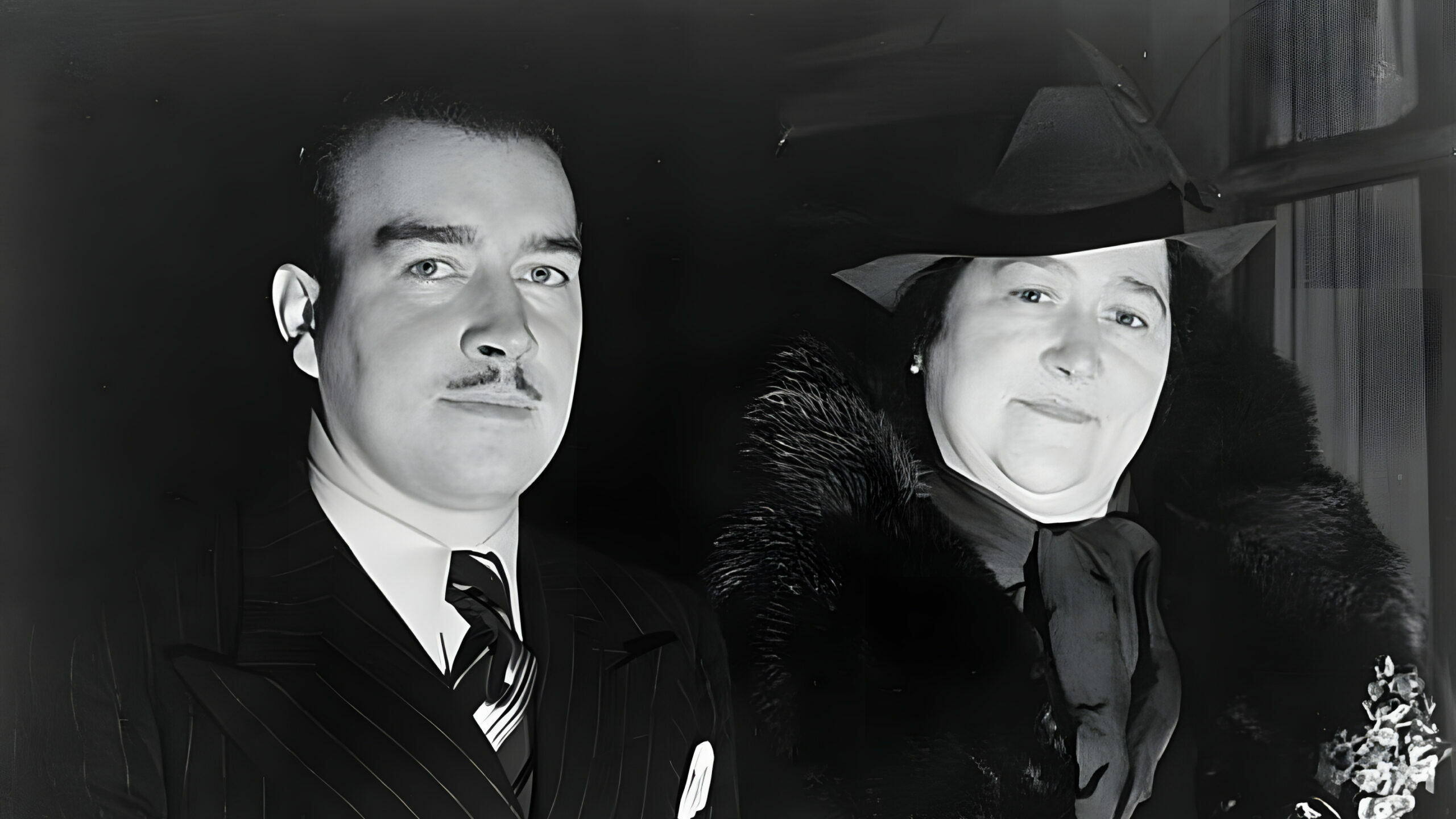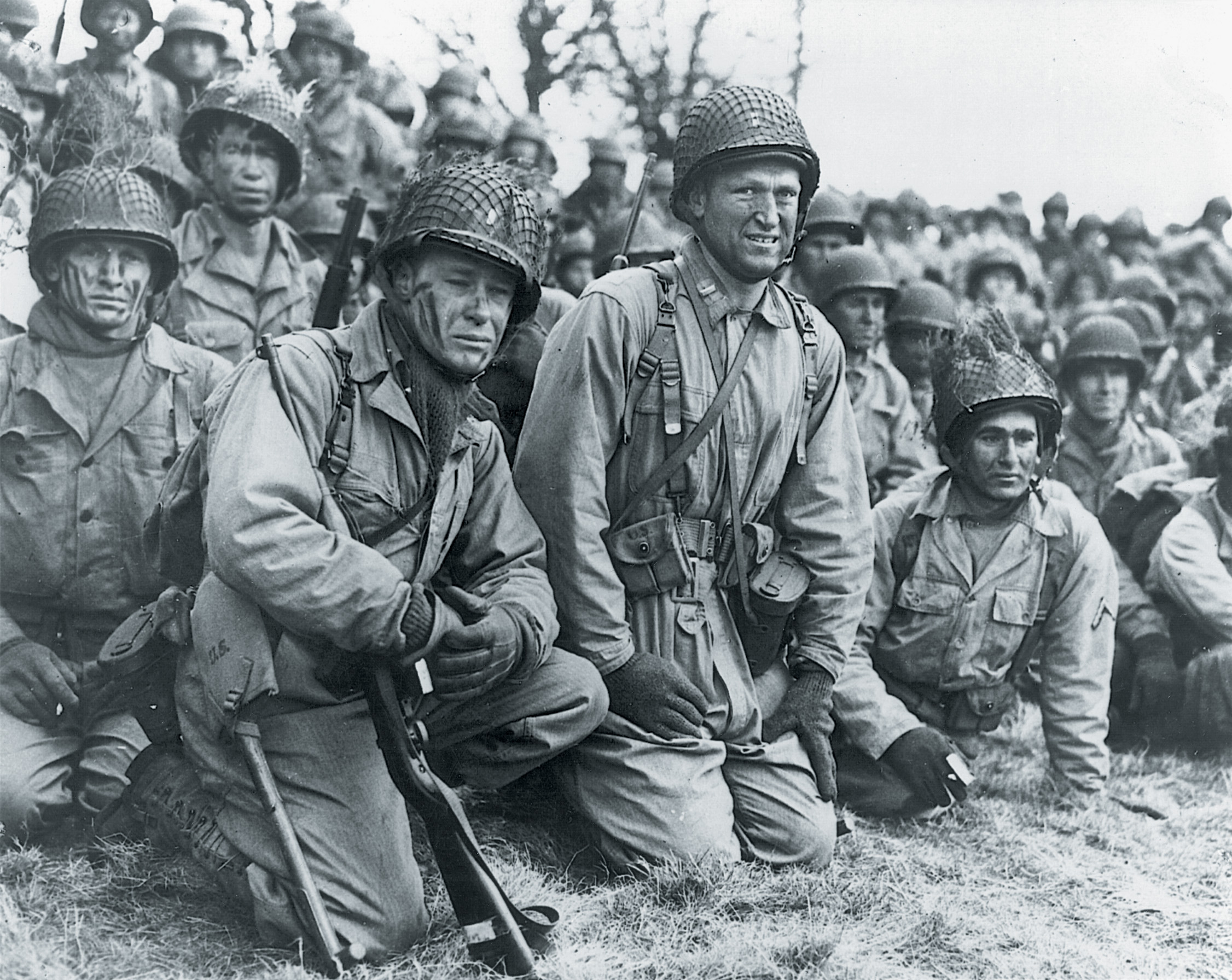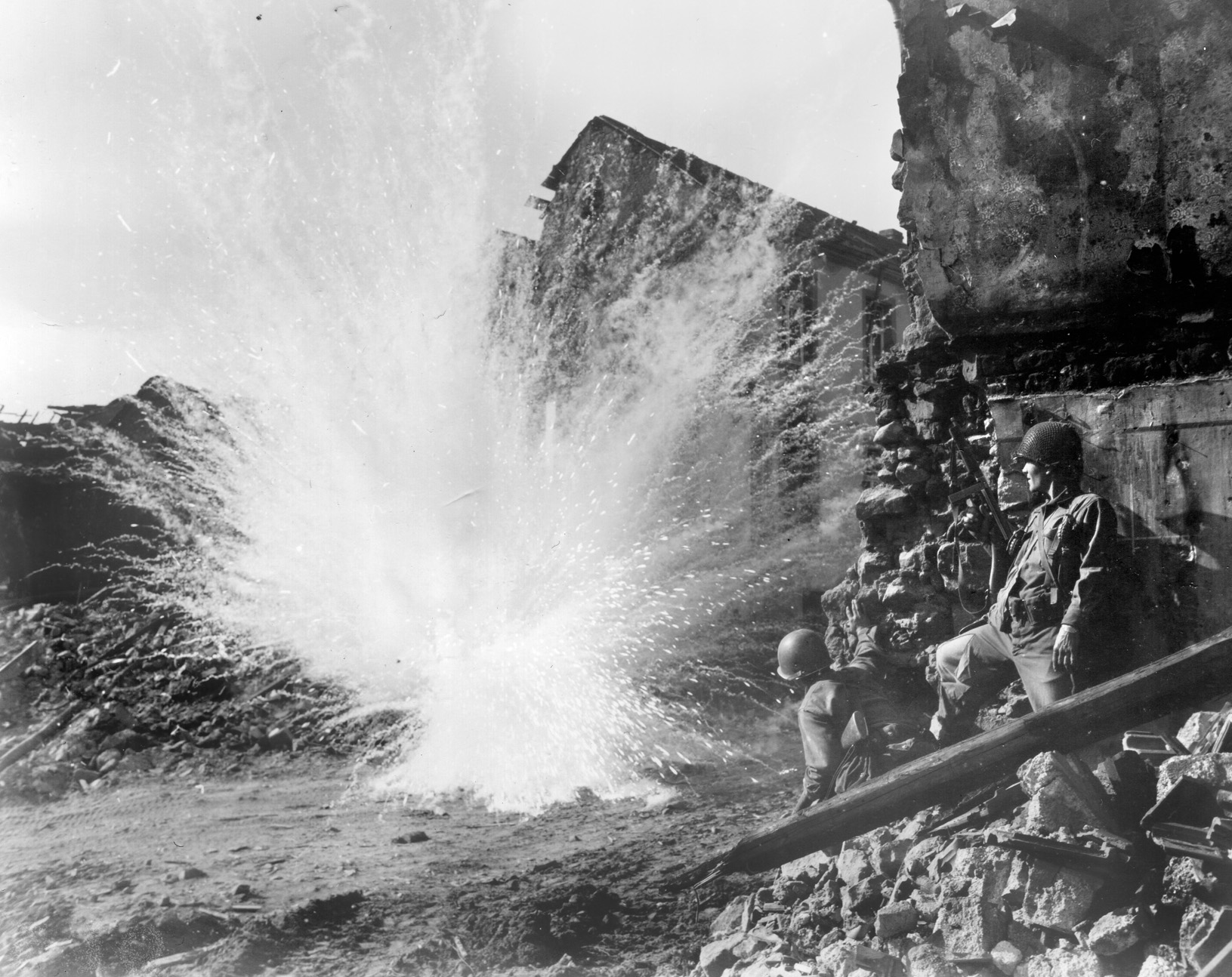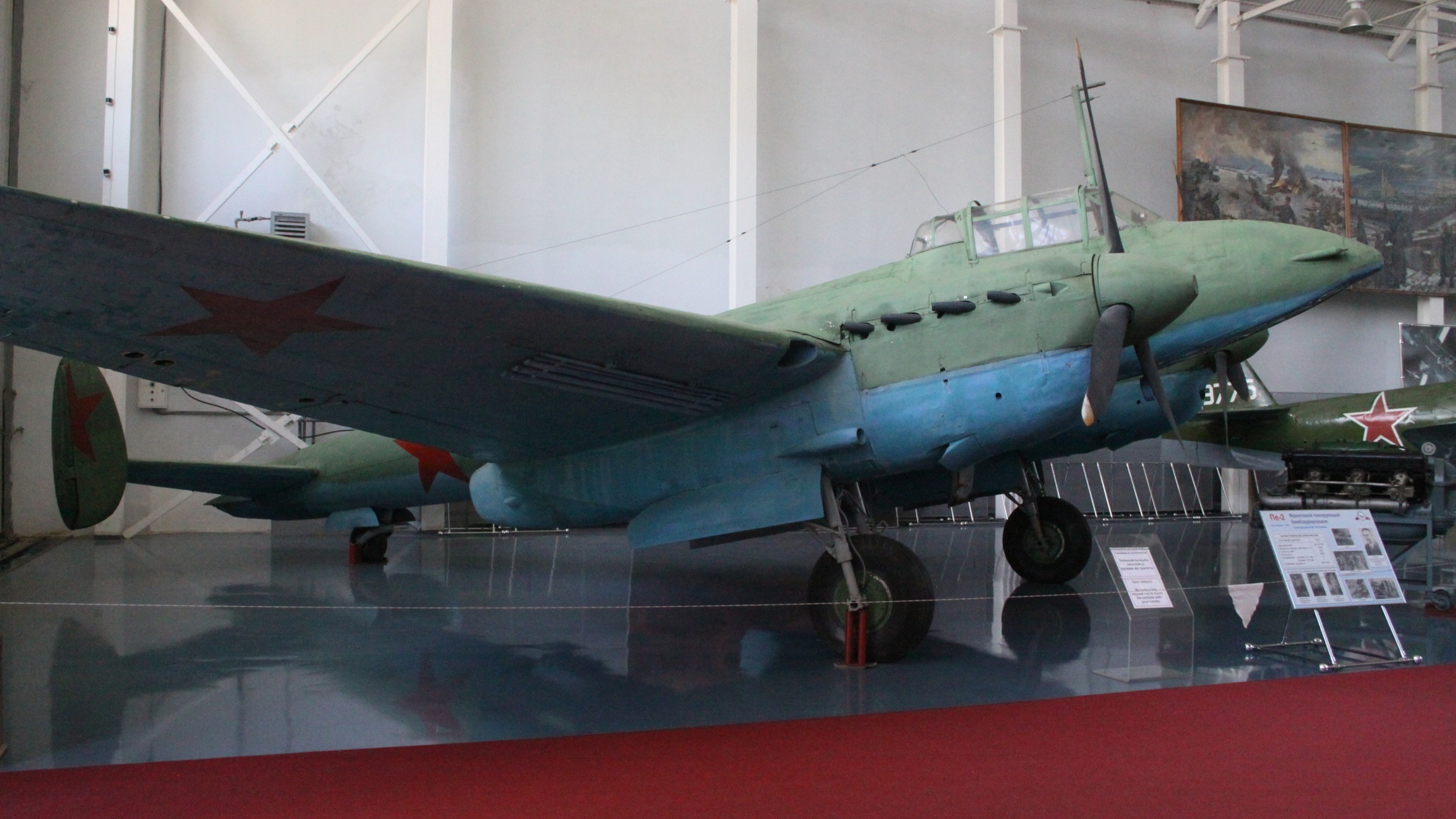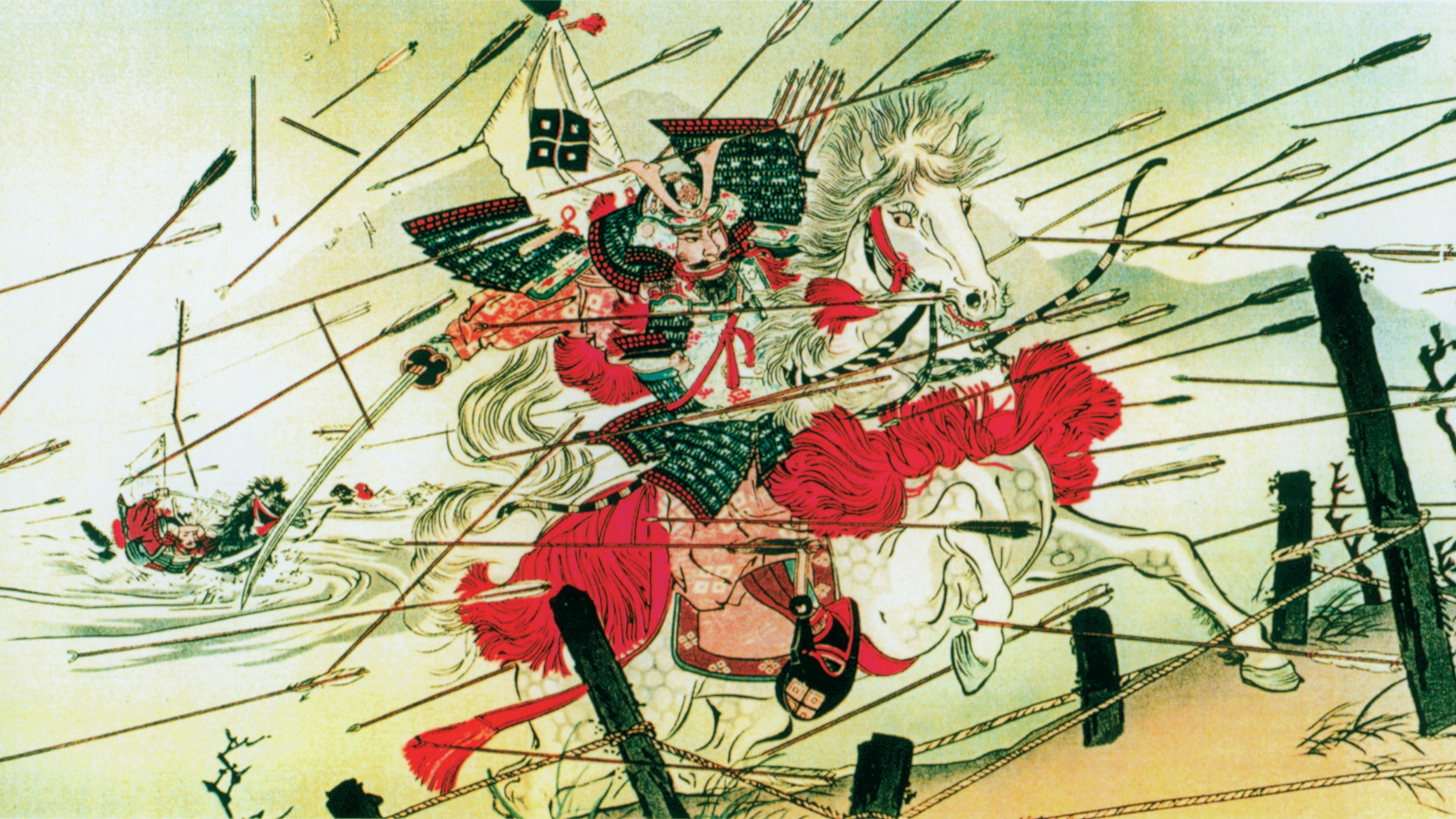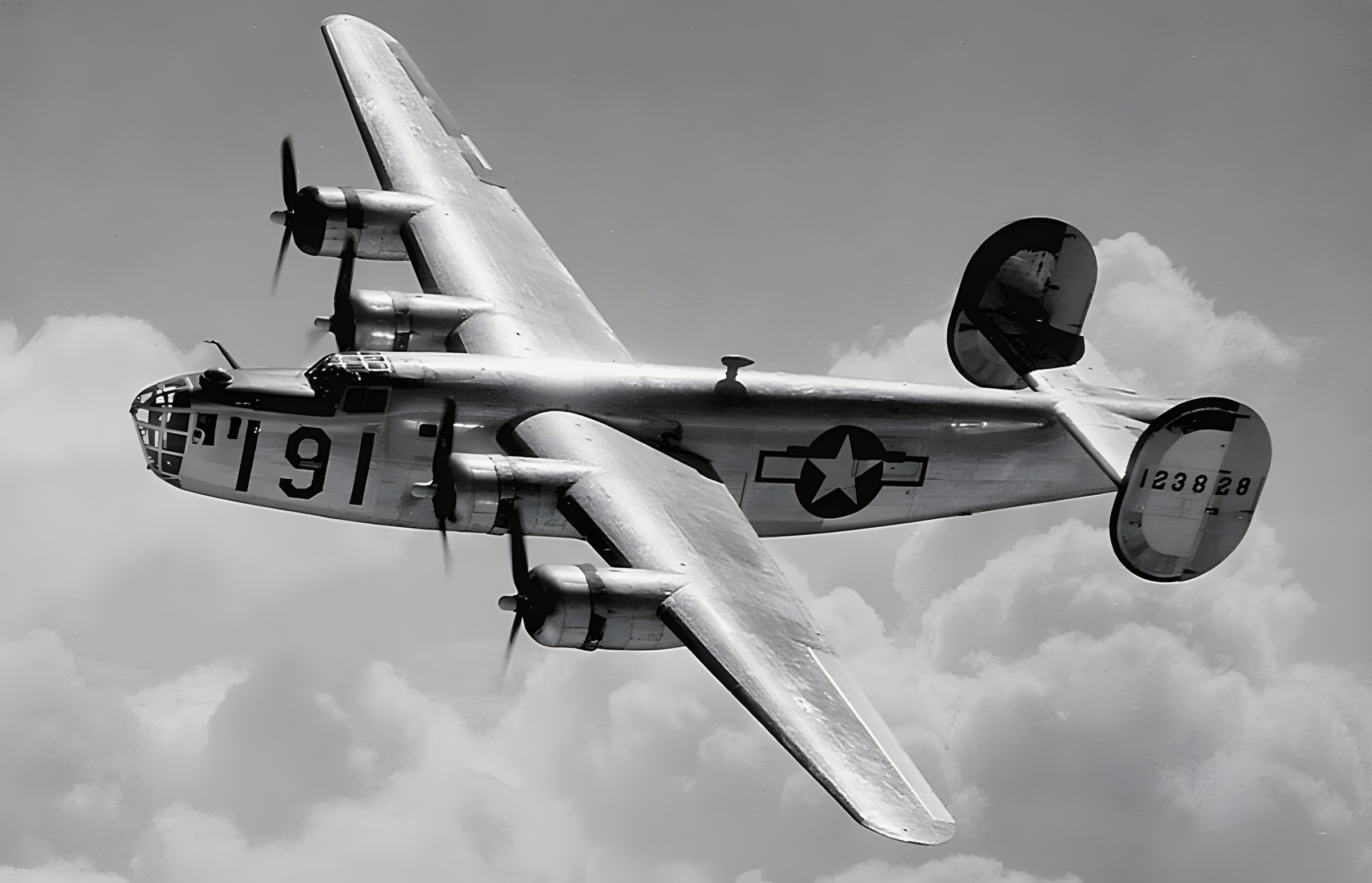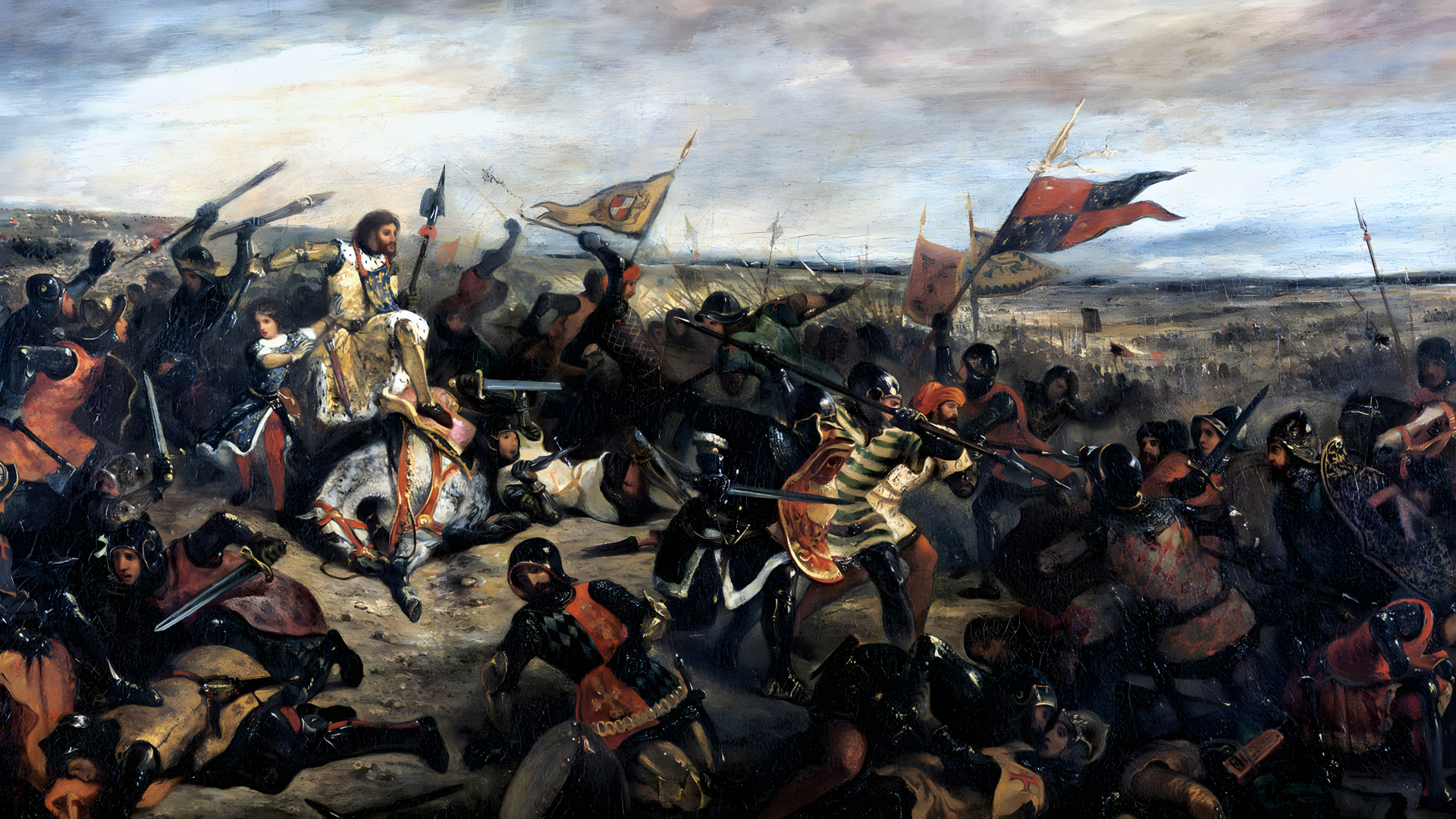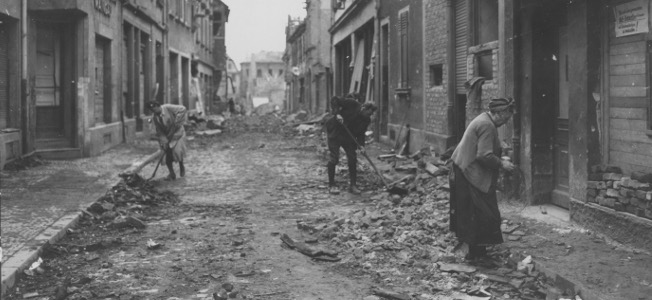By William F. Floyd Jr.
On December 4, 1950, Jesse Brown, U.S. Navy Ensign and the Navy’s first African American aviator, was flying 1,000 feet above the icy Korean mountains in his Corsair when its engine cut out. Brown was strafing Chinese troops near the Chosin Reservoir when his plane was brought down by enemy small arms fire that hit the aircraft in a vulnerable spot. The Vought F4U Corsair went down heavily and crashed into the rough terrain, folding up at the cockpit and streaming smoke from the wreckage. The rugged, propeller-driven, big-nosed design could normally sustain a lot of damage, but on that day, Brown had been tragically unlucky.
Lieutenant Junior Grade Thomas Hudner and the other Strike Fighter Squadron VF-32 pilots flying from the carrier USS Leyte viewed the situation on the ground as they circled above. Chinese Communist soldiers were bound to discover the wreckage given that the crash occurred so close to the Chosin Reservoir. The other Navy pilots initially thought Brown was dead, but they soon saw him waving his hand. However, the 24-year-old pilot’s legs had become entangled in the damaged instrument panel. Flight leader Richard Creole radioed “Mayday” and called for a helicopter. A Sikorsky H-5 helicopter was dispatched but it would be at least 15 minutes before it arrived on station.
Hudner looked down at his friend and flying mate and quickly decided to go down and attempt to pull Brown from the smoldering aircraft. If all went well, both pilots could escape in the helicopter. Hudner made a treetop pass and dumped his remaining fuel and ordnance before preparing to land alongside Brown’s stricken plane. He landed his Corsair, hitting the ground a lot harder than expected. When on the ground Hudner began to wonder if this had been such a good idea. He quickly shook off the thought and surveyed the situation.
When the two-man Marine helicopter arrived with only its pilot, the two tried to free Brown from the cockpit, but their herculean efforts proved useless. Brown was slipping in and out of consciousness and losing blood. With daylight fading they discussed using a knife to cut off Brown’s trapped leg, but neither could bring themselves to do it. It was obvious that Brown was likely to perish if he did not receive medical care. With darkness setting in and the temperature dropping, the two reached the grim decision to leave Brown behind.
Back on the Leyte, Hudner pleaded with his superiors to be allowed to return to the crash site to help extract Brown, but he was denied on the grounds that the enemy might ambush the rescue helicopters. If that happened, the Navy might suffer additional casualties. Brown inevitably succumbed to his injuries. For his heroic attempt to rescue Brown under extreme weather conditions and the threat of enemy attack, Hudner was awarded the Medal of Honor. His valor was a reflection of the pride felt by all Corsair pilots in both World War II and the Korean conflict.
In World War I the Vought O2U- and O3U-series observation airplanes were the first aircraft to bear the name Corsair. These sturdy aircraft were used by the airborne Navy in the late 1920s and early 1930s.
The story of the World War II-era Corsair began in February 1938 when the U.S. Navy Bureau of Aeronautics published two requests for proposals for twin-engine and single-engine fighters. For the single-engine fighter, the Navy requested the maximum obtainable speed, and a stalling speed (the slowest speed a plane can fly to maintain level flight) of not higher than 70 miles per hour. The Navy also specified a range of 1,000 miles. The fighter must carry four guns, or three with increased ammunition, and be able to carry antiaircraft bombs on the wing.
In June 1938 the U.S. Navy’s Bureau of Aeronautics contracted with Vought Aircraft for a prototype, the XF4U-1. After a mock-up inspection in February 1939, construction of the XF4U-1, powered by a Pratt & Whitney R-2800 18-cylinder radial engine rated at 1,805 horsepower, received approval. When the prototype was completed it had the biggest and most powerful engine, the largest propeller (13 feet in diameter) ever fitted to a single-engine aircraft, and the largest wing span of any naval fighter to date.
The first flight of the Corsair prototype took place on May 29, 1940. The flight proceeded normally until a hurried landing was made when the elevator trim tabs failed because of flutter. Engineers quickly corrected the problem.
Testing of the XF4U-1 would continue for some time. The Navy became so impressed with Vought’s prototype that a formal request was issued to build a production model. This was followed by an order for 584 aircraft on June 30, 1941, to be designated F4U-1. The Navy’s requirements would change from lessons learned in Europe. This led to additional armor protection, self-sealing fuel tanks, and heavier armament in the production model.
These new changes would make a dramatic difference in the appearance of the production model from its original prototype. The bomb compartments in each wing were taken out of the production model.
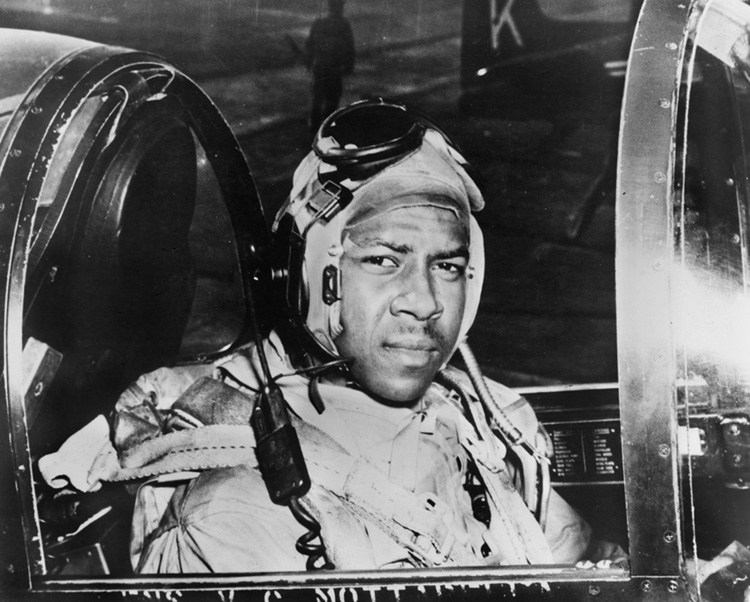
The main armament consisted of six .50-caliber machine guns, three in each wing. The change meant the fuel cells located in the wings had to be relocated and redesigned. They were consolidated into one main fuel cell located in the forward fuselage between the engine and the cockpit. Putting the main fuel tank (257-gallon capacity) in the forward fuselage also meant that the Corsair’s nose had to be extended 12 feet in front of the cockpit. The long nose pushed the cockpit back behind the aircraft’s bent wing, known as a “gull wing.” The air rushing into the aircraft’s intakes at high speed produced a whistling sound that led to the aircraft being nicknamed “Whistling Death.”
One drawback of the cockpit position was that it adversely affected the pilot’s forward and downward view, making carrier landings more difficult. The first production F4U-1 Corsair was flown on June 25, 1942. Vought delivered the first production models to the Navy the following month.
The F4U engine was the largest available at the time: a 2,000 horsepower, 18-cylinder Pratt and Whitney R-2800 Double Wasp radial engine. To obtain as much power as possible a relatively large Hamilton Standard Hydromatic three-blade propeller was used. The Corsair’s aerodynamics would be more advanced than those of contemporary naval fighters. The XF4U-1 became the first single-engine U.S. fighter to fly faster than 400 miles per hour.
The Corsair’s poor visibility during landing approaches, its adverse stall characteristics, and slow approach speed made it initially undesirable as a carrier aircraft. Perhaps worst of all, it had a tendency to bounce on hard landings. For these reasons, it failed carrier takeoff and landing tests conducted on September 25, 1942.
Navy pilots who were dissatisfied with its performance derisively referred to the Corsair as the “hog.” For these reasons, Navy officials preferred to stick with the Grumman F6F Hellcat as their principal carrier aircraft, even though it was not equal to the F4Us superb performance in combat. Of course, this was not a problem for the Marines given that their pilots typically flew from airfields. Initially, the Navy approved the Corsair only for the Marines and for Navy airfields. The Navy would eventually clear the Corsair for carrier operations in 1944.
Marine squadrons quickly took to the new fighter, which turned out to be more of a fighter for them than the Navy. The Corsair soon became associated with famous squadrons in the Pacific, such as the Marine Corps’ VMF-214, known as the “Black Sheep,” and land-based Navy Fighter Squadron VF-17 deployed in the Soloman Islands, nicknamed the “Jolly Rogers.”
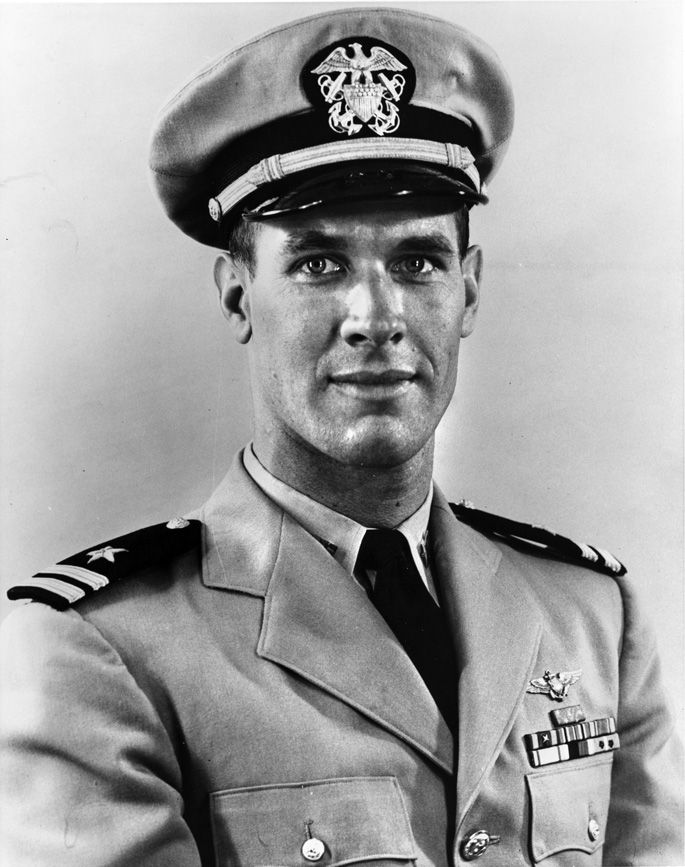
The Corsair was in such heavy demand when cleared for combat in late 1942 that the Navy awarded some additional production contracts to Goodyear to meet the additional demand. From 1942 through 1953, the Corsair had the longest production run of any U.S. piston engine fighter. A total of 12,582 Corsairs (16 different models) were manufactured between 1942 and 1952.
The first operational squadron to use the F4U-1 in combat was VMF-124, led by Major William E. Gise. Corsair pilots of Marine fighter squadron VMF-124 took to the skies from Henderson Field on Guadalcanal on February 12, 1943, to escort a U.S. Navy PBY Catalina on a rescue mission. Two days later, the Marine pilots engaged the Japanese in air-to-air combat for the first time. The Corsairs were attacked by approximately 50 Japanese Zeros. The pilots of VMF-124 were beginning to realize their aircraft’s advantages over the Zero in future engagements.
First Lieutenant Kenneth A. Walsh, a former enlisted pilot, was part of this first combat mission. “The F4U could outperform the Zero in every aspect except slow speed maneuverability and slow speed rate of climb,” wrote Walsh. “It took time, but eventually we developed tactics that overcame any shortcomings. When we were accustomed to the area and knew our capabilities, there were instances when the Zero was little more than a victim.”
In the Pacific Theater during World War II, Corsairs downed 2,149 Japanese aircraft while flying 64,051 missions. Only 189 Corsairs were lost in combat in the Pacific Theater. It would not be long, though, before the Corsair went back into action in a new conflict.
The division of Korea can be traced back to the close of World War II when the Soviet Union occupied the northern half of the peninsula and the United States occupied the southern half. United Nations-supervised elections led to the establishment of the Republic of Korea in the south, while Korean communists established the Democratic People’s Republic of Korea in the north. With the onset of the Cold War, it was apparent that Korea was not going to be peacefully reunited.
Shortly after North Korea invaded South Korea on June 25, 1950, the Corsair saw action. On July 3 the U.S. Navy launched Corsairs from the USS Valley Forge. These aircraft included 16 F4U-4B Corsairs loaded with rockets. The rocket-armed Corsairs struck enemy airfields and rail yards at Pyongyang without losing a single aircraft.
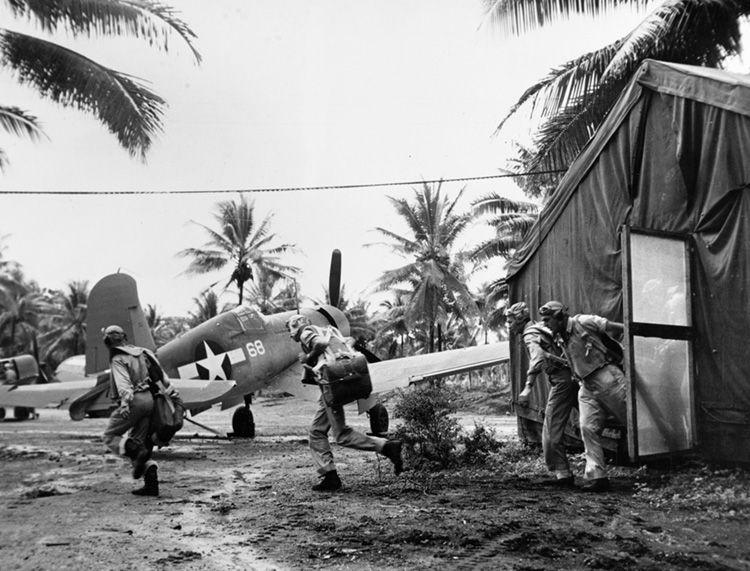
The initial U.S. Navy close air support mission would be flown on July 22 in support of the Eighth Army. This was followed by an emergency combat air support mission three days later with only minimal success. There were issues with radio equipment, maps, and mission requirements. As a result of radio problems, the Corsairs and other aircraft hunted targets on their own.
The need for close air support saw dramatic changes with the entrance of the First Provisional Marine Brigade into the war. The Marines were well trained in the use of combined arms, which included using close air support to its greatest advantage. The Navy-Marine Corps combat air support mission had very little red tape, which allowed Corsair pilots to respond very quickly when called upon. Soldiers fighting with the Marines were surprised by the response times, accuracy, and proximity at which the missions took place.
In August alone, Navy and Marine Corsairs flew 6,575 combat hours. During the Battle of the Pusan Perimeter, Corsair units from Marine Aviation Training Support Group 33 flew 1,511 missions, with 995 of those being urgent air support missions. At the time, the United Nations’ defensive perimeter had shrunk to an area around the southernmost part of Pusan. It was critical that this area be protected. The port was a key link in the logistics chain supporting United Nations’ forces in their efforts to recover the Korean peninsula.
Marine aviation would carry out its mission, relying on its ability to operate afloat as well as from land. The basing of planes on escort carriers USS Sicily and Badoeng Strait proved the commonality between Naval and Marine aviation. Because the carriers were so close to the battle zone, the strikes could reach their targets in a matter of minutes at almost any point where support was needed. Most importantly, it was apparent that the Marine air-ground team concept used at the Pusan Perimeter could be used in similar operations on the Korean peninsula.
On September 18 United Nations ground forces captured Kimpo Airfield. After the airfield was prepared, additional Corsair squadrons arrived from Japan. Marine Corsair squadrons moved north in support of the 1st Marine Division, operating from Wonsan and later from Yonpo Airfield in North Korea. The system of close air support faced its greatest test in November and December 1950 as Chinese troops reinforced the North Koreans. Both Navy and Marine Corps squadrons played a crucial role in the 1st Marine Division’s breakout from the Chosin Reservoir. United Nations forces at the Chosin Reservoir were up against hordes of Chinese troops. Initially they were encircled by the Chinese, but they were eventually able to break out. After they broke out, they withdrew to Hungnam where they inflicted substantial casualties on the attacking Chinese. VMF-312 with its F4U-4s accumulated nearly 2,000 hours, losing four aircraft and one pilot during the fighting withdrawal.
Corsairs flew continuous orbit over the 1st Marine Division during daylight hours, with night fighters operating after dark. The pilots used multi-channel radios to stay in contact with troops on the ground and phosphorous rockets to indicate potential targets.
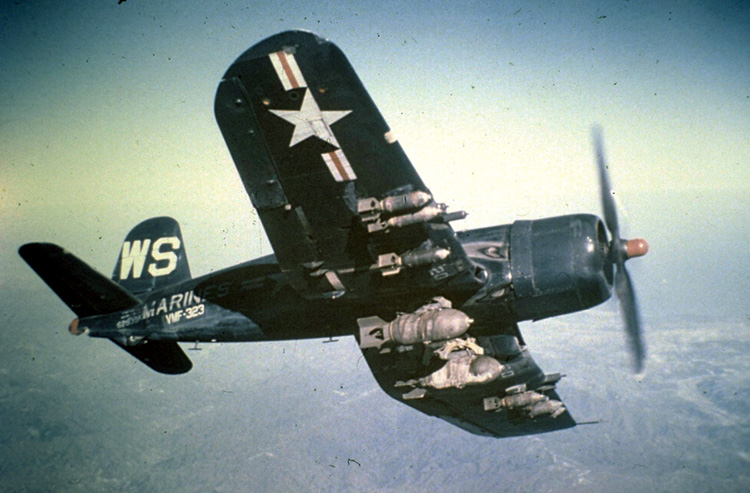
The first victory for a Marine Corsair during the Korean War took place on April 1, 1951, when former World War II ace Captain Phillip DeLong led a division on an armed reconnaissance mission. The division took off from the USS Bataan. Each Corsair was armed with a 500-pound bomb, drop tank, six high-velocity aircraft rockets, and two 100-pound bombs. Two Corsairs were detached to escort a rescue helicopter to pick up a downed flyer. DeLong and his wingman, Lieutenant Harold Daigh, continued with the mission. They soon came in contact with four enemy aircraft. Through a series of complicated and dangerous maneuvers, the two Marine pilots avoided being shot down. They were credited with three kills and one probable. They both were able to land safely on the Bataan even though both aircraft had sustained considerable damage.
In early September 1951, Marine pilots had their first encounter with Soviet MiG fighters. Captain Jesse Folmar and his wingman, Lieutenant William L. Daniels, spotted a pair of MiG 15s getting into position to make a pass at the Corsairs. More MiGs soon arrived. After a short initial dogfight, the two Marine pilots prepared to depart the area when Folmar radioed his wingman to resume combat. The two pilots executed a 35-degree diving turn to port. After an attack on his plane, Folmar was forced to bail out after transmitting a search and rescue distress signal. The MIGs soon headed for home, and Folmar was rescued after being in the water for only eight minutes. Lieutenant Daniels’ Corsair was able to get back to the USS Sicily undamaged. The two pilots had taken on eight MIGs and came away with each side losing one aircraft.
The Navy’s only ace piloting a Corsair in the Korean War was Lieutenant Guy P. Bordelon Jr. While flying an F4U-SN, Bordelon was patrolling United Nations’ front lines against nuisance raids by the North Korean Peoples Air Force. Bordelon would be credited with destroying three Soviet Lavochkin La-11 fighters during three separate missions. The last aerial victory for a Navy Corsair was when Bordelon shot down an La-11, which made him the only propeller aircraft ace of the war. For his achievements in the skies over Korea, Bordelon received the Navy Cross.
Aircraft of this era were typically judged on their performance, lethality, durability, technological advances, and the number produced. The F4U Corsair scored well in all of these categories, but when one takes into consideration categories such as longevity, mission, diversity, adaptability, and timeliness, the Corsair usually came out on top.
During the Korean War, the availability of the Corsair saved countless lives on the front in some of the most dangerous operating locations on the peninsula. It could stay on station longer and carry a heavier payload than the early Navy jets. The Corsair would continue to be used into the late 1960s by other nations, such as France, New Zealand, and several Latin American countries.
